
By Arthur Holland Michel and Dan Gettinger
On Friday, March 25, the Federal Aviation Administration released 582 new reports of incidents involving unmanned aircraft in the U.S. airspace system. These reports date from August 21, 2015 to January 31, 2016. We have conducted a preliminary analysis of this new data. Our findings are summarized below.
We will publish an in-depth analysis of these reports in an updated edition of our December 2015 report, “Drone Sightings and Close Encounters: An Analysis.” This report includes a detailed background of the issue, our methodology for analyzing incident reports, and an analysis of over 900 incidents from 2014 and 2015.
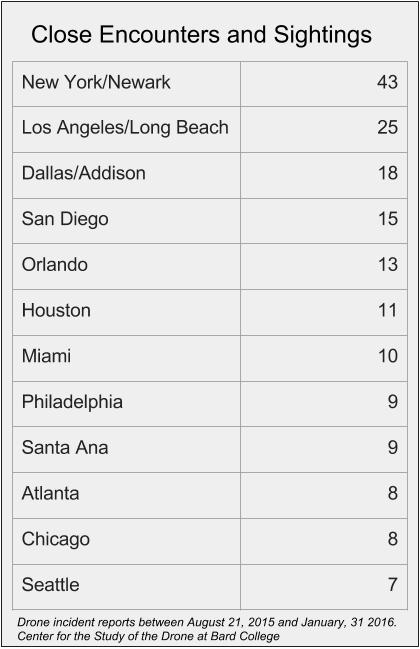 Preliminary Findings
Preliminary Findings
- Generally, the patterns observed in the new reports match trends observed in reports of incidents from previous FAA data releases.
- Just over one third of all incidents were Close Encounters, i.e. incidents that present a level of potential hazard.
- The rate of reported incidents continues to be higher than in previous years. This period saw over three times as many incidents as the same period of the previous year.
- Three out of five incidents occurred within five miles of an airport, and nine out of ten incidents occurred above 400 feet.
- In 24 incidents, drones reportedly came within 50 feet of a manned aircraft. In 11 instances, aircraft made evasive maneuvers to avoid a drone.
- Roughly one third of all reported Close Encounter incidents involved a multi engine jet aircraft.
Incident Types
From the original set of 582 incident reports released by the FAA, we have identified 519 unique reports of either Sightings or Close Encounters involving drones in the national airspace. (Our total tally of reports is lower because the FAA’s release includes a handful of duplicate reports as well as reports in which drones were not clearly interfering with manned aircraft or flight paths and a few reports of incidents involving balloons).
We define Close Encounters as incidents where a drone comes within 500 feet of a manned aircraft, when a pilot declares a “Near MidAir Collision,” when a pilot takes evasive action to avoid a potential collision, or when the pilot uses descriptive language that indicates the drone as being dangerously close (for example: “almost hit” or “passed just above”). We define Sightings as incidents in which drones are within aircraft flight paths but do not pose any immediate potential threat. By these criteria, 188 incidents, or 36.2 percent, were Close Encounters and 331, or 63.8 percent, were Sightings.
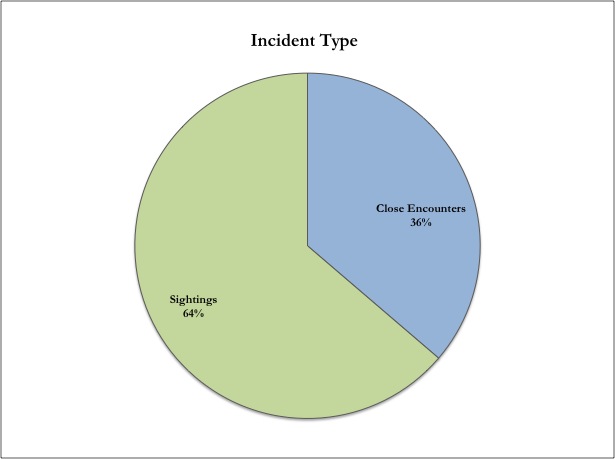
The new data shows that the rate of incidents remains higher than in previous years. In the same period over the previous year (August 2014 to January 2015) there were 169 incidents. August 2015 saw the highest number of incidents of any month on record, with 186 reported Sightings and Close Encounters. The number of incidents dropped in November, December, and January compared to the summer. However, a similar drop was observed in the winter of 2014/2015. Every month from August 2015 to January 2016 saw approximately three times the number of incidents that occurred in the same month of the previous year. In the same full period over the previous year (August 2014 to January 2015) there were 169 incidents.

Incidents from the new dataset are shown in orange.
Distance from Airports
Of the 411 Close Encounter and Sighting incidents in which a distance from an airport was recorded, 243, or 58.8 percent, occurred within five miles, and 170, or 41.2 percent, occurred beyond five miles from the nearest airport (we observed exactly the same proportion in reports of incidents from previous releases). The average distance from an airport was 6.46 miles.
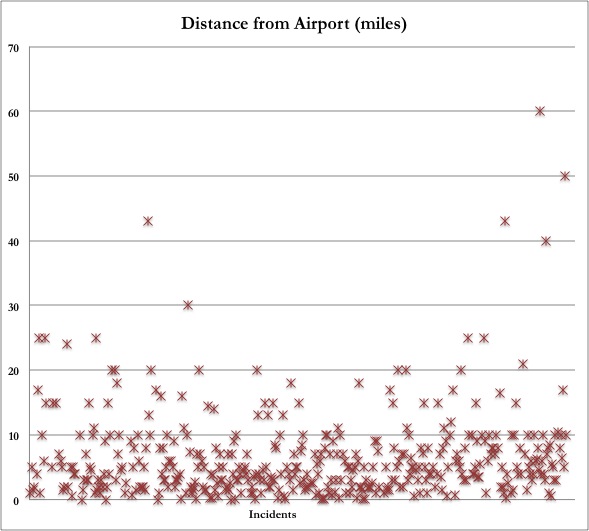
Incident Altitude
Most incidents occurred above the FAA’s 400-foot ceiling for unmanned aircraft. Of the 470 incidents for which an altitude was reported, 38, or 8.1 percent of all incidents with a reported altitude, occurred at or below 400 feet, and 432 incidents, or 91.9 percent, occurred above 400 feet. The average altitude for incidents was 3,074 feet, and the median altitude was 2,000 feet. Note: While most incident reports are likely to record an Above Ground Level (AGL) altitude, some incidents in the database indicate an Above Mean Sea Level (MSL) altitude or a Flight Level (FL), which is based on barometric pressure.
Incidents beyond five miles of an airport tend to occur at much higher altitudes than incidents within five miles of an airport. The average altitude of incidents with a recorded airport distance of more than five miles was 4,146 feet. The average altitude of incidents that occurred within five miles of an airport was 2,048 feet. 
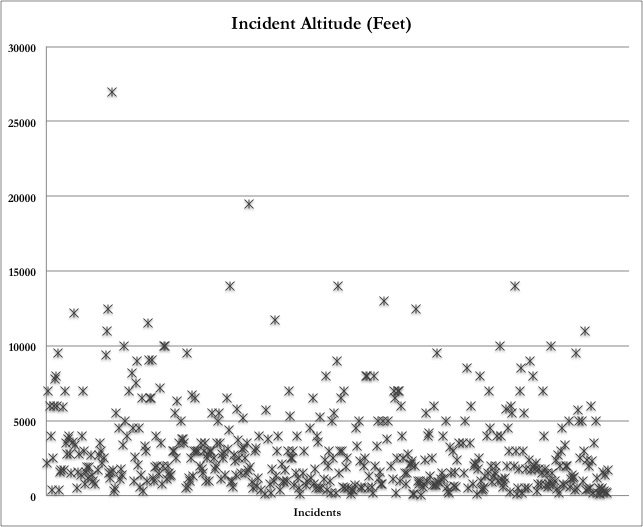
Close Encounters
Of the 188 reports of Close Encounters that we identified, 167 indicated the distance between the drone and the manned aircraft (that is, a proximity of 500 feet or less). In 24 of these incidents, the drone passed within 50 feet of the manned aircraft. In 103 incidents, the proximity was 200 feet or less. Twenty one Close Encounter reports did not include a stated proximity.
In 11 cases, a pilot reported taking evasive action to avoid a drone. In some incidents, the report simply states that “no evasive action was taken,” and does not specify whether evasive action might have been advisable. In other reports, pilots recorded that no evasive action was necessary, even in instances where the proximity to the drone was less than 500 feet.
Drone Type
Of the 153 incidents reports in which we were able to identify the drone type, 127 incidents involved multirotor drones, 24 involved fixed-wing drones, and two involved helo-type drones.
Manned Aircraft Type
For Close Encounter Incidents, we identify the type of manned aircraft that was involved. We found that 65 Close Encounters, or 32.2 percent, involved multi engine jets (52 of which were commercial passenger jets), 85 involved single engine prop aircraft, and 20 involved helicopters.
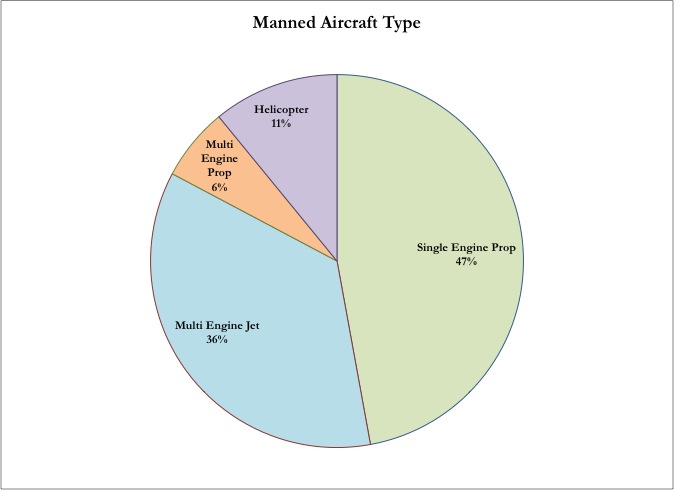
Law Enforcement
Many of the pilot and air traffic reports in the database mention that a local law enforcement entity investigated the incident. A possible drone sighting near LaGuardia Airport by a Pinnacle Airlines pilot on September 25, 2015—the same day that Pope Francis was visiting New York—prompted air traffic officials to notify the U.S. Secret Service. The August 2015 to January 2016 dataset also saw a slightly higher number of incidents in which the Federal Bureau of Investigations was notified—roughly 5 percent compared to 2 percent in the September 2014 to August 2015 dataset.
For our December 2015 report, “Drone Sightings and Close Encounters: An Analysis,” click here.
For updates, news, and commentary, follow us on Twitter.
[includeme file=”tools/sympa/drones_sub.php”][/fusion_text]

